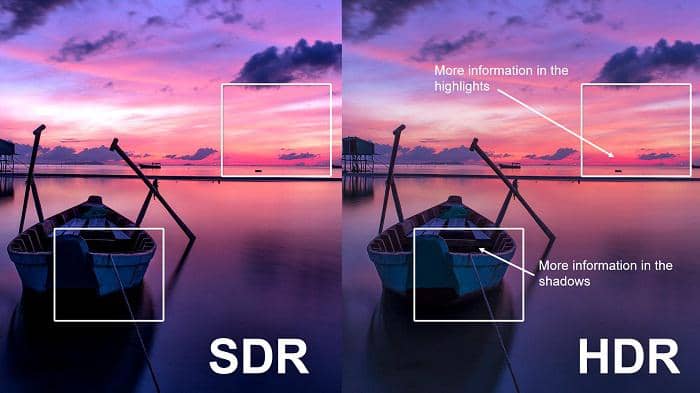- My Forums
- Tiger Rant
- LSU Recruiting
- SEC Rant
- Saints Talk
- Pelicans Talk
- More Sports Board
- Coaching Changes
- Fantasy Sports
- Golf Board
- Soccer Board
- O-T Lounge
- Tech Board
- Home/Garden Board
- Outdoor Board
- Health/Fitness Board
- Movie/TV Board
- Book Board
- Music Board
- Political Talk
- Money Talk
- Fark Board
- Gaming Board
- Travel Board
- Food/Drink Board
- Ticket Exchange
- TD Help Board
Customize My Forums- View All Forums
- Show Left Links
- Topic Sort Options
- Trending Topics
- Recent Topics
- Active Topics
Started By
Message
TV Question: Explain HDR
Posted on 2/23/23 at 12:34 pm
Posted on 2/23/23 at 12:34 pm
and why I might need it. I need a new TV and I’ve found a huge gap in prices on what I’ve looked at. It seems the cheaper ones are not good on HDR content. I’ve tried to read explanations but they most refer to HDR content as needing it. What shows have HDR content?
Posted on 2/23/23 at 12:38 pm to Auburn80
more colors available to display on the screen. Just makes coloring of videos better.
Pretty much all new shows from streaming services come in HDR (usually Dolby Vision but sometimes HDR10+). HLG is another form of HDR that will be used for OTA HDR when it arrives.
EDIT: when you get into the HDR types, Dolby Vision and HDR10+ allow greater contrast between dark and bright scenes due to dynamic metadata.
Pretty much all new shows from streaming services come in HDR (usually Dolby Vision but sometimes HDR10+). HLG is another form of HDR that will be used for OTA HDR when it arrives.
EDIT: when you get into the HDR types, Dolby Vision and HDR10+ allow greater contrast between dark and bright scenes due to dynamic metadata.
This post was edited on 2/23/23 at 12:39 pm
Posted on 2/23/23 at 12:49 pm to Auburn80
Most new shows and movies on streaming services are released in HDR.
HDR stands for High Dynamic Range. The two main benefits are an increased amount of colors the TV is able to display and the ability to display bright areas and dark areas on screen at the same time. In other words more like how your eyes work. You can go outside on a sunny day and still see details in shadows.
In SDR the TV will either show a bright image and crush blacks, removing all details in dark areas or show a dimmer image and reveal details in the dark areas.

HDR stands for High Dynamic Range. The two main benefits are an increased amount of colors the TV is able to display and the ability to display bright areas and dark areas on screen at the same time. In other words more like how your eyes work. You can go outside on a sunny day and still see details in shadows.
In SDR the TV will either show a bright image and crush blacks, removing all details in dark areas or show a dimmer image and reveal details in the dark areas.

Posted on 2/23/23 at 12:56 pm to Auburn80
Your phone should have an HDR settings on its camera.
Turn the lights off in your house. From the middle of your room, take a photo of the outside through the window. Your inside the house will be dark and outside will look normal. Now do the same with HDR turned on. Now you should see inside the house and outside the window. That is what HDR brings.
TVs also tie an expanded color space as well to HDR.
Turn the lights off in your house. From the middle of your room, take a photo of the outside through the window. Your inside the house will be dark and outside will look normal. Now do the same with HDR turned on. Now you should see inside the house and outside the window. That is what HDR brings.
TVs also tie an expanded color space as well to HDR.
This post was edited on 2/23/23 at 12:59 pm
Posted on 2/23/23 at 1:17 pm to Auburn80
quote:
why I might need it
To be honest the people who care the most about things like HDR either want the newest tech or are the types of people who want to see movies and TV shows as the creators intended.
If you're watching a lot of SDR content and have never thought about things like color accuracy, I wouldn't stress over HDR performance. Get the biggest TV you can afford that will work in your room.
Posted on 2/26/23 at 6:50 pm to JoeHackett
High Dynamic Range, such as shot on a RED Komodo camera, has an available 21 stops of dynamic range. The camera's are able to discern levels of details in the shadows and highlights that can only be reproduced with a video display set comparably equipped. Canon has filed a new patent and announced a new sensor with 738 individual zones, each able to act independently of the others, and with 27 stops of dynamic range. I'm anxious to see if this is a RED killer.
These cameras are able to obtain both an overexposed image and underexposed image. By combining them, the crisp details and highlights from each combine to form a more dynamic, deeply colorful image.
These cameras are able to obtain both an overexposed image and underexposed image. By combining them, the crisp details and highlights from each combine to form a more dynamic, deeply colorful image.
Posted on 2/27/23 at 7:29 am to JoeHackett
quote:
LINK
While the definition is correct, the are in the box in the above photo are not the highlights. They are technically mid-tones. I took the liberty of highlighting the actual highlights...

As you can see in the updated the highlights on the SDR image are blown out to pure white. In the HRD image there is more color information there.
Popular
Back to top

 4
4









